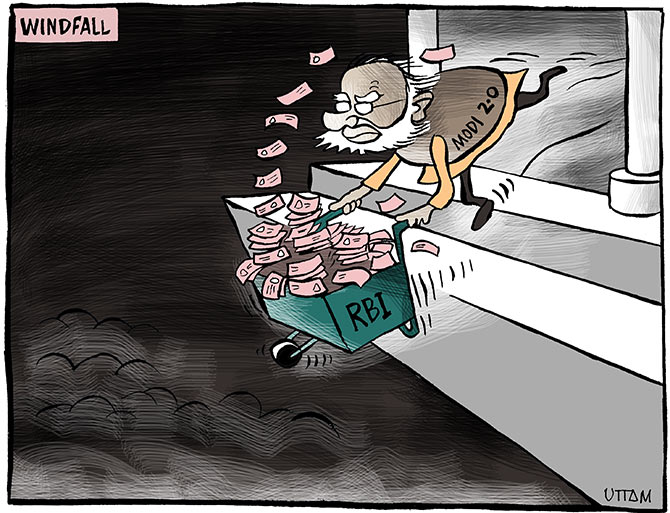 | « Back to article | Print this article |
When emerging from this crisis, the govt must consider a fresh approach to reviving growth, revisiting the Centre-state fiscal balance, and devising a re-imagined GST 2.0, suggests T N Ninan.

There are several well-known reasons for the fiscal mess that sits on the central government's plate, but let's start with one that is not often discussed: The greater share of revenue that has gone to the states.
Back in 2013-2014, the states got 28 per cent of the Centre's gross tax revenue.
By 2017-2018, this share had gone up to 35 per cent.
Since then, the Centre has found various ways of clawing back some of the lost ground; last year, the states's share was 31 per cent.
Central transfers as a share of the states's own revenue have climbed from 45 per cent in 2013-2014 to 62 per cent (Budget estimates for 2019-2020).
The Centre's net tax revenue has grown 102 per cent, while its tax transfers to the states have gone up by as much as 168 per cent.
The states's total revenue (tax and non-tax) has grown 132 per cent over the six years, compared to 93 per cent for the Centre.
And the states-to-Centre ratio of total government receipts has pivoted from 56:44 to 65:35.
For every rupee that the Centre now spends, the states spend almost two.
This is a massive swing in fiscal resources and power.
Why be surprised that the Centre finds itself fiscally constrained while states budgeted for a revenue surplus in 2019-2020?
The Centre has not helped itself with some crazy (there is no other way to describe it) budgeting.
It ignored the revenue slowdown already in evidence in 2018-2019 and budgeted expansively for revenues in 2019-2020 of Rs 17.05 trillion, reduced post-elections to Rs 16.50 trillion.
The end result was a shortfall of over 20 per cent on the original target, an outcome that may have few or no precedents.
The fiscal deficit, 48 per cent of total revenue in 2013-2014, had been brought down to 37 per cent by 2016-2017 (the pre-GST year), but soared to 53 per cent for 2019-2020.
If you look at the actual numbers rather than the ratios, the deficit shot up by a stunning 45 per cent in just one year -- without counting off-balance sheet borrowing.
There is a pattern to these fiscal numbers.
All ratios, like tax to GDP, improved after 2013-2014, when the economy began to emerge from a trough.
The uptick continued till 2016-2017.
Average GDP growth in the 2014-2017 period flattered at close to 8 per cent.
After that, it has been bad news all the way.
The growth slowdown has steadily accelerated, dropping to less than half the level that it had reached.
The ratio of indirect tax to GDP, for instance, has dropped from 5.6 per cent to 4.9 per cent, or even lower, accounting for the entire drop in the ratio of total tax to GDP.
It is ironic that the promise held out for GST was that it would improve the tax-GDP ratio.
The actual experience has been the opposite of that, though the growth slowdown could well have influenced the outcome.
It is this darkening backdrop of the last three years that has left the Centre with no fiscal cushion to deal with the Covid pandemic.
This year's budgeted net tax revenue for the Centre, implying an increase of more than 20 per cent on the base, is impossible to achieve when the economy is shrinking.
Expenditure increases to boost the economy are inevitable.
The fiscal deficit could climb from the already bloated 53 per cent of total Central revenue last year to as much as 65 per cent this year.
That means two out of every five rupees that the government spends will be borrowed money.
To be sure this is a crisis year, and there will be departures from the usual rules of fiscal prudence.
Still, when emerging from this crisis, the focus will inescapably have to be on what built up to today's situation.
That means a fresh approach to reviving growth, re-visiting the Centre-state fiscal balance, devising a re-imagined GST 2.0, accepting the limits of what is feasible as a social safety net when the tax-GDP ratio is what it is, and looking to better outcomes from existing levels of spending.
Production: Aslam Hunani/Rediff.com